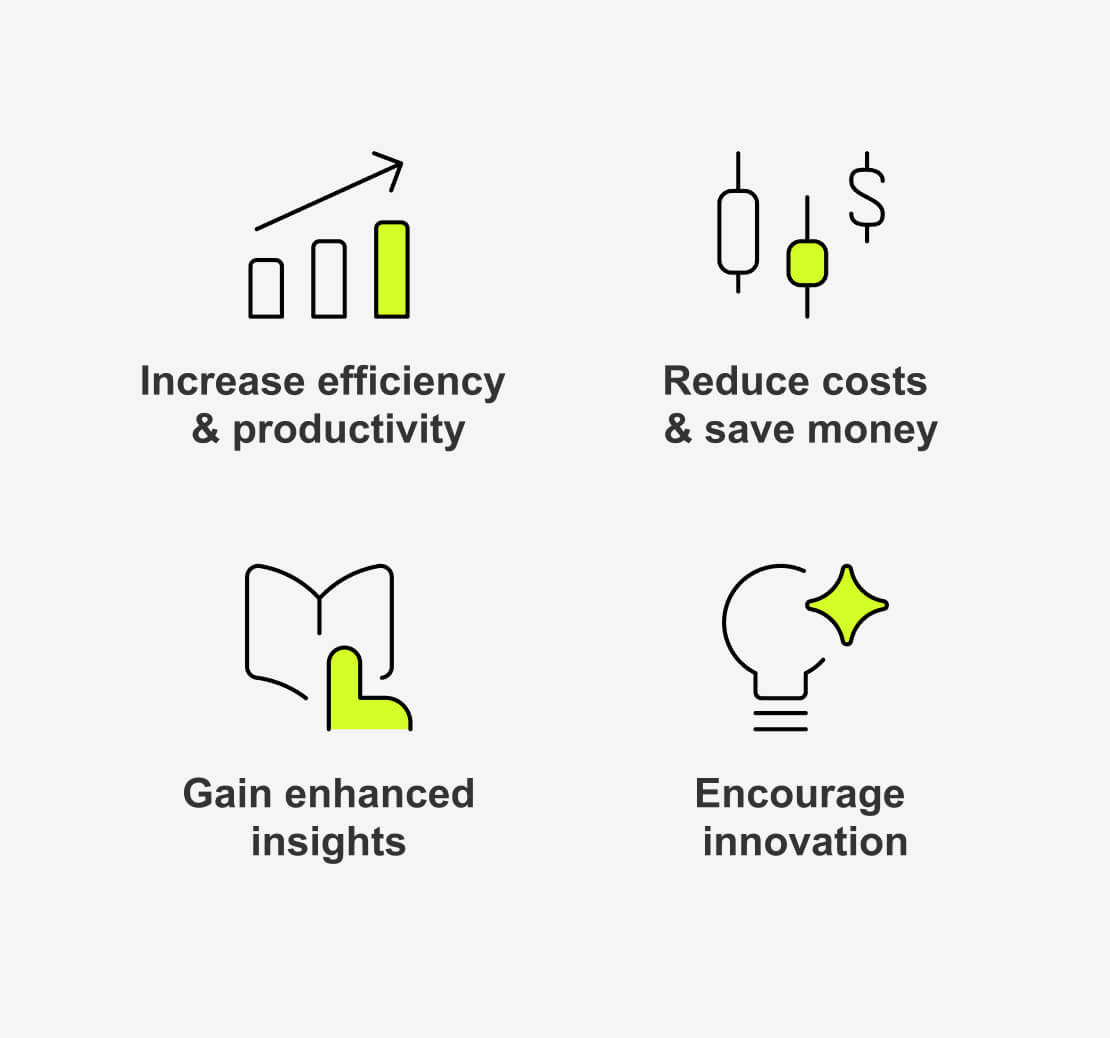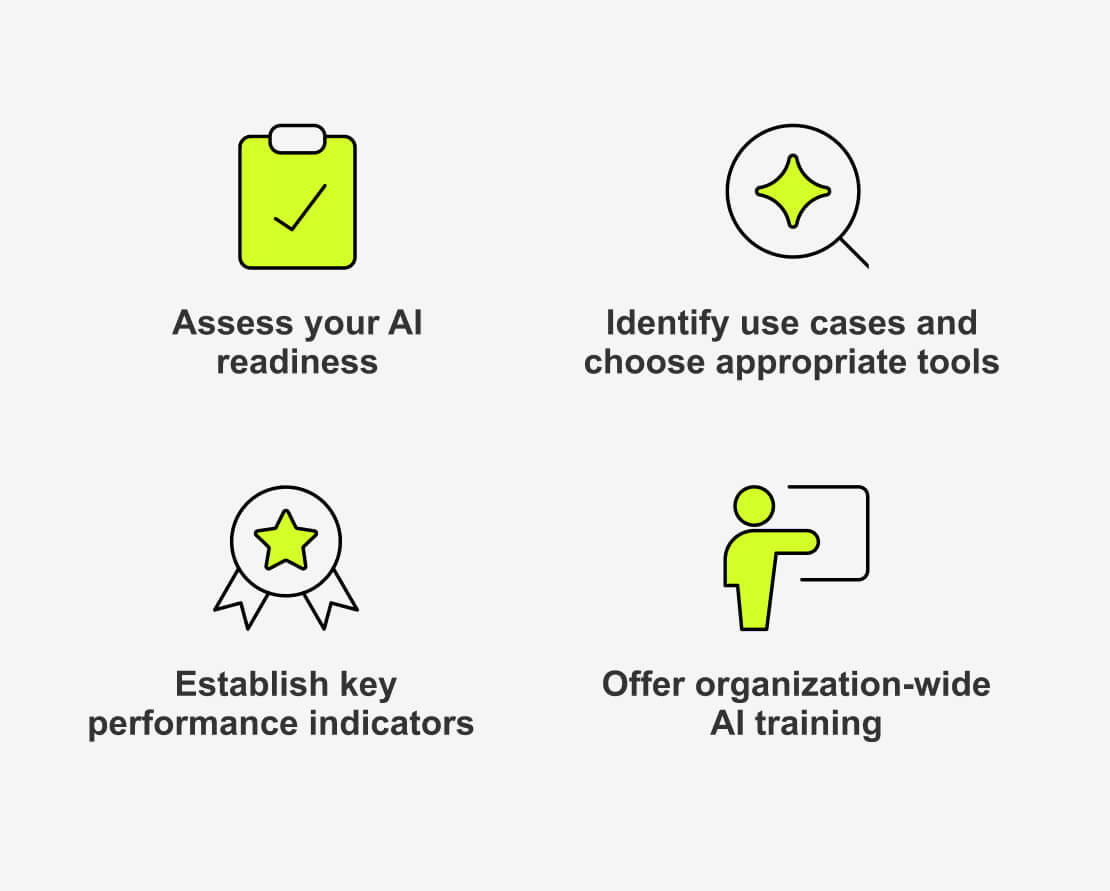Integrate AI Into Your Business Processes: Best Practices for Success
A global team of technologists, strategists, and creatives dedicated to delivering the forefront of innovation. Stay informed with our latest updates and trends in advanced technology, healthcare, fintech, and beyond. Discover insightful perspectives that shape the future of industries worldwide.
AI and machine learning technologies can solve many business problems as many exciting use cases across industries have shown. However, the integration process is often fraught with technical challenges and can leave companies with suboptimal solutions if not handled properly. This blog starts by identifying some of the business benefits of artificial intelligence, before providing tips and best practices to help you successfully integrate AI into your business processes.

Blog contents
- Why integrate AI into your business processes?
- Increase efficiency and productivity
- Reduce costs and save money
- Gain enhanced insights
- Encourage innovation
- Tips for a successful AI integration
- Assess your AI readiness
- Identify use cases and choose appropriate tools
- Offer organization-wide AI training
- Establish key performance indicators
- Get world-class support for your AI integration
Why integrate AI into your business processes?
Adopting artificial intelligence and incorporating it into your business workflows can help you:


Increase efficiency and productivity
AI can help improve productivity throughout the business by automating repetitive, time-consuming tasks and performing them much faster. Examples include processing incoming job applications, triaging and assigning helpdesk incidents, and tracking equipment maintenance cycles. It takes this work off the shoulders of overburdened human employees and gives them more time to spend on complex and creative workflows that further drive efficiency and revenue.
Reduce costs and save money
AI can help reduce operational costs in several ways. It can analyze complex bills, like those from cloud service providers, and identify unnecessary expenses or wasted, unused resources. AI predictive maintenance tools can also help identify potential issues with automated machinery before they become expensive, line-stopping catastrophes. These cost savings can eventually offset the expense of adopting AI technology.
Gain enhanced insights
AI can analyze vast amounts of data from any source and generate meaningful, actionable insights organizations can use to improve their processes. For example, AI can help identify inefficiencies in manual or automated workflows that are impacting productivity. It can also uncover potential upsell opportunities in customer data to improve revenue.
Encourage innovation
Since AI helps automate some of the most frustrating and tedious tasks, it frees employees to get creative and come up with innovative new ideas for driving the business forward. AI’s ever-expanding list of capabilities also unlocks a wide-open field of potential use cases and products to help companies stand out from the competition.
Tips for a successful AI integration
Taking the following steps prior to adopting new AI technologies will help ensure a successful, streamlined integration.


Assess your AI readiness
This step is crucial, but companies often overlook it in their rush to adopt exciting new AI technologies. An AI readiness assessment ensures that an organization has a solid foundation for new artificial intelligence integrations, reducing adoption headaches and allowing it to see faster value from its investment.
Key questions to ask as part of an AI readiness assessment include:
AI Readiness Assessment Questions
| Category | Questions |
| Business Alignment | Does the business have:
|
| Data Readiness | Are there policies and tools in place to ensure:
|
| AI Model Performance | Basic mobile apps with limited functionality
|
| AI Infrastructure | Does the team have an MLOps (machine learning for IT operations) framework to:
|
| Security and Compliance |
|
| Organizational Readiness |
|
Identify use cases and choose appropriate tools
The most successful AI implementations result from aligning specific business use cases with the right AI models and tools to solve those particular problems. One approach that can prove helpful is to start by playing with different AI solutions to discover what capabilities are available. Then, write a list of business problems and match them up with the tools that can solve them. These problems should be prioritized based on their overall impact on business processes and the organization’s ability to address them with the available AI tools.
For example, a major business problem that can be solved with an out-of-the-box AI solution, like an inability to accurately predict automated equipment maintenance schedules, should be prioritized above a less urgent issue that requires a custom-developed tool. Strategically prioritizing and aligning use cases with AI solutions will maximize the effectiveness and value of the resulting AI integration.
Offer organization-wide AI training
One benefit of conducting an AI readiness assessment is that it will help determine who in the organization needs training and what areas to focus on. This training should go beyond general awareness – teams need to understand the differences between generative AI and machine learning or statistical methods. This distinction is key to making informed decisions about what can be handled internally and what requires outside expertise. AI literacy training should be incorporated into regular IT and information security training for anyone expected to interact with artificial intelligence or machine learning systems. This training should include the team responsible for building, integrating, and maintaining AI tools, as well as the end users who are involved in the affected workflows. Robust AI training will help streamline the integration and adoption process.
Establish key performance indicators
It’s important to determine the metrics by which you’ll measure the success of the AI integration. This process should be customized to the use cases established earlier, but some example key performance indicators (KPIs) include:
- Error rate – The number of errors divided by the total number of task attempts
- Task speed – How quickly tasks are completed compared to pre-AI
- Cost savings – How much money is saved in labor, maintenance, etc.
- Revenue growth – What revenue looks like compared to pre-AI
- Employee productivity – How many tasks are employees completing each week with the assistance of AI
- Support requests – How many end-user issues relating to the AI system are being fielded by the helpdesk team
Get world-
class support
for your AI integration
10Pearls is an AI-driven product engineering company with the expertise to help you successfully integrate AI into your business processes. Our AI/ML leads are seasoned strategists with deep expertise in advanced and emerging technologies, assessing your AI readiness to help you select the right tools and craft custom AI-first solutions that solve unique problems and support your company through the entire integration process. This combination of technical depth and business acumen enables our AI/ML leadership to guide complex, high-impact AI initiatives for enterprise clients.
Reach out for a free consultation to discuss your AI integration needs.
Empower your business with artificial intelligence
Cut through AI hype – future-proof your business with AI


